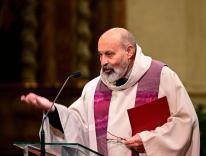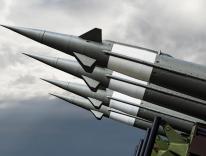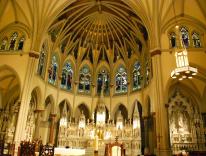Every now and then a book appears that redefines a field. This is one of those occasions. Despite the reservations detailed below, Sword of the Spirit, Shield of Faith qualifies as a masterful work of history. In the course of his comprehensive exploration of the relationship between religion and American statecraft, Andrew Preston makes one point above all abundantly clear: there simply is no understanding the latter without giving careful attention to the former. Whether justifying or criticizing the exercise of power, Americans routinely enlist God to serve their cause, sublimely confident of their ability to interpret his intentions.
By any measure this is a big—even gargantuan—book. In lesser hands it might have been a tedious one. Yet in addition to being a prodigious researcher, Preston, a Canadian currently teaching at Cambridge University, writes crisply, has an eye for the pungent quotation, and does not shy away from bold judgments. The result is a feisty, engaging, and provocative text.
Preston’s account begins with the founding of Anglo-America and ends up several hundred years and several hundred pages later with the period since 9/11. To summarize his story is necessarily to oversimplify it. Yet the gist of the tale goes like this: Even as the American religious landscape has evolved—the early hegemony of the Puritan divines giving way over time to a more ecumenical, less explicitly Christian civil religion—a strong, religiously sanctioned sense of American exceptionalism has persisted. This deep-seated conviction of being God’s new chosen people gave rise to a “faith-based ideology of expansion,” imparting to U. S. policy an abiding impulse either to dominate or to redeem, the one aim being for all practical purposes interchangeable with the other. American wars therefore became “crusades”—Preston identifies five just since 1898, with the Global War on Terrorism the most recent—with religious voices more often than not clamoring for a go at anyone obstructing the spread of truth, freedom, and the American way. At intervals some believers may question or even oppose the exercise of American power. Yet on the whole religiously based dissent has tended to be ineffectual, with God (in our own eyes at least) remaining firmly on our side.
To substantiate this argument, Preston cites the testimony of two groups. The first consists of people (largely clergy) who inhabit the world of religion but comment on politics. The second consists of people (for the most part U. S. presidents) who inhabit the world of politics, but employ religious language or scriptural references to frame their policies.
For my money, the first of the two groups is the more interesting. Whether the matter at hand involved removing bothersome natives, invading Mexico, annexing the Philippines, waging war to end all war, or resisting godless communism wherever it might raise its ugly head, militant churchmen demonstrated an extraordinary capacity to explain why Jesus himself would surely endorse the ever-wider exercise of American power. Typical is this comment by the Reverend George Cheever, pastor of Manhattan’s Church of the Puritans, writing in 1841: “Our whole existence shall be a lofty course of freedom and piety, expansive as the world, and lasting as the continent we inhabit.” Cheever’s book God’s Hand in America sanctified the fervor that informed Manifest Destiny. “The Christian spirit,” Preston aptly observes, “was often in communion with that of imperialism.”
Yet on precisely the same issues, other believers found reason to question claims of American righteousness. A nation hell-bent on expansion (or on exercising “global leadership”), they suggested, was putting its soul at risk. Even when these critics lost the argument, as was usually the case, they left a rich and inspiring legacy, amply displayed in Preston’s account. Even—or especially—in the present day, that legacy retains considerable relevance.
As for the pols, Preston is surprisingly willing to credit religious convictions with shaping their actions in office. Let us concede that understanding presidents like Woodrow Wilson or George W. Bush becomes impossible without taking into account their fervent religiosity. Even in these cases, however, discerning whether faith serves as motive force or self-rationalization or handy sales pitch requires the skills of a seer (or confessor) rather than those of a scholar. When justifying war, after all, why draw attention to economic entanglements (in Wilson’s case) or to oil (in Bush’s) when there is evil to be vanquished and God’s work to be done?
Yet divining the relationship between belief and policy becomes more challenging still when dealing with presidents like Franklin Roosevelt, Dwight Eisenhower, and Ronald Reagan, who wore the mantle of faith lightly and mostly on ceremonial occasions.
Preston describes FDR, for example, as someone possessing “a simple faith.” If so, faith was the only attribute of this inordinately complex, calculating, self-absorbed, and inscrutable man to which the word simple applies. In that regard, Preston’s effort to credit Roosevelt with a “faith-based vision of politics and peace” is unpersuasive and, frankly, implausible. In fact, with all the cynicism and dexterity of a master politician, FDR deployed religion when it suited his purposes and ignored it when it posed a problem. So during World War II, the Soviet Union got a pass on religious liberty: Preston notes that “in deference to the Soviet Union” the Atlantic Charter was silent on the issue. On the other hand, Nazi Germany’s record of religious persecution marked that nation for destruction.
Granted, there were times when religion got the better of the president, as for example, when he made contradictory and irreconcilable promises to Zionist Jews and Arab Muslims. Here too, as in so many other respects, Roose-velt set precedents that both instructed and ensnared his successors.
The Catholic thread in Preston’s narrative describes a process of progressive assimilation purchased through willing cooptation. During the colonial period and for the first century or more after the Revolution, a predominantly Protestant establishment viewed “the satanic Catholic conspiracy” as global enemy number one and “the root of all evil.” In the eyes of Protestant elites, preachers and politicians alike, Catholicism was “tightly centralized, inherently autocratic, expansionist, and aggressive”—and therefore incompatible with fundamental American values. As a rallying cry for war, nothing worked like the putative threat posed by popery.
Guided by bishops intent on overcoming this pervasive bigotry, the American church exerted itself to demonstrate that there is no contradiction between being a good Catholic and being a good American. Time and again, war presented the opportunity to make that case. So in 1917 when Cardinal James Gibbons called on every American Catholic to maintain “an absolute and unreserved obedience to his country’s call,” the aim was as much to win favor in Washington as to strike fear in the hearts of the Boche. The hierarchy led by Gibbons wasted no time in creating a National Catholic War Counsel, thereby reassuring Wilson that the church stood foursquare behind his crusade to crush militarism and make the world safe for democracy. Thanks to the Great War, Preston writes, Catholics (and Jews) “were becoming full partners in, rather than adjuncts to, an American Creed.”
This pattern continued in World War II before reaching its apotheosis during the protracted crusade that was the Cold War. The Roman Catholic Church had always despised communism; with anticommunism now emerging as central tenet of an increasingly generic civil religion—pretty much subsumed in the phrase “One Nation under God”—American Catholics finally achieved full equality. With the Kremlin displacing Rome as global conspiracy headquarters, American Catholics found themselves once and for all on the right side of the barricades, a process ratified in 1960 by the election of a glamorous (if not especially devout) Catholic as president. If religion had become “a weapon in the Cold War,” as Preston writes, Catholicism itself formed part of the nation’s arsenal.
Not all Catholics supported this de facto alignment of church with emergent national security state. Ever since the 1930s, the Catholic Worker movement—“a noisy minority who raised troubling questions”—had borne eloquent witness to a different definition of church. Yet Preston allots only glancing attention to the Catholic Workers, treating radical pacifism as a fringe phenomenon more or less single-handedly discredited by Reinhold Niebuhr. Granted, Dorothy Day commanded no more battalions than the pope. Still, in a “history of American foreign relations, told predominantly through a religious lens,” it’s by no means clear that criteria of power should determine Day’s standing.
Preston shows greater interest in the more confrontational (not to say theatrical) activism of the Berrigan brothers and other Catholics who opposed the Vietnam War, recounted here in considerable detail. In a book replete with sharply rendered judgments, however, Preston doesn’t know what to make of Vietnam-era protest. “It is impossible to know definitively,” he writes, “whether this religious opposition to the war had an effect on policy.”
What seems clear is that whatever clout a faith-based critique of foreign policy may have carried back in the 1960s, those days are gone, probably for good. The watering down of American civil religion that enabled American Catholics to claim a place at the table today leaves them (and other people of faith) with little to say to power. What little they do have to say is easily ignored (with the bishops’ 1983 pastoral on war and peace the exception that proves the rule—we’ve seen nothing like it since). When bishops (or ministers or rabbis) presume to instruct Washington on matters pertaining to war and peace, senior officials—almost all of them professed believers—will listen politely, but that’s about it. (Unless, that is, the message is one that Washington happens to endorse, in which case: Well, welcome to the Oval Office).
In his concluding chapter, Preston rightly notes the renewed interest in Niebuhr, regularly cited these days by politicians and pundits of all persuasions. In official circles, a Niebuhr revival of sorts is in full swing. But to see this as signifying a revival of Christian realism (or Christian anything) would be a mistake. In present-day Washington Niebuhr has become a lapel pin. So too with the role of religion in foreign policy discourse: it is at best an ornament, pulled out of storage for the odd occasion, but neither valued nor carrying any weight.


